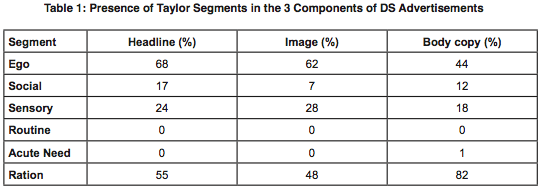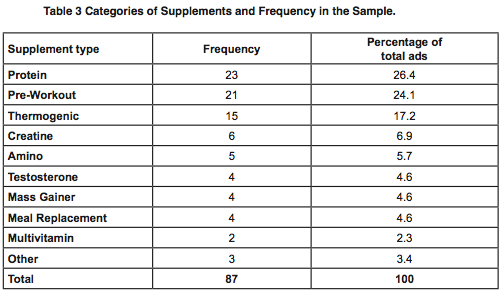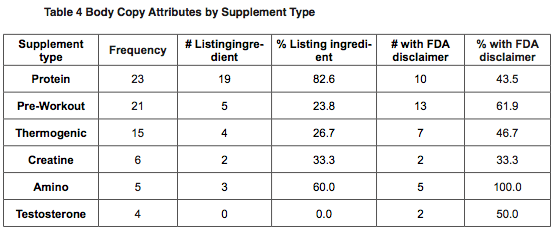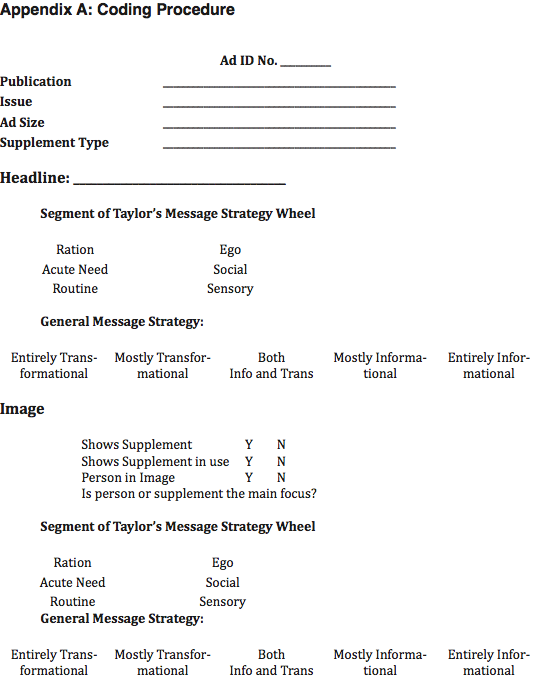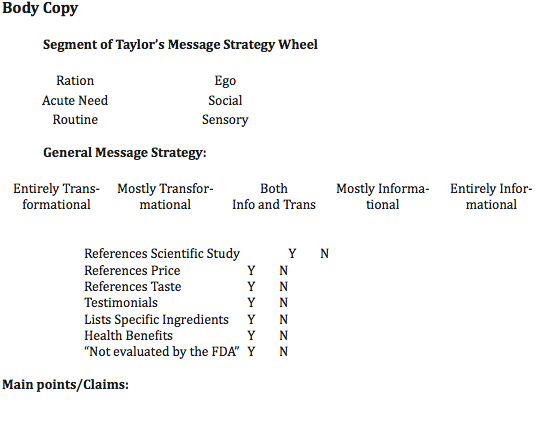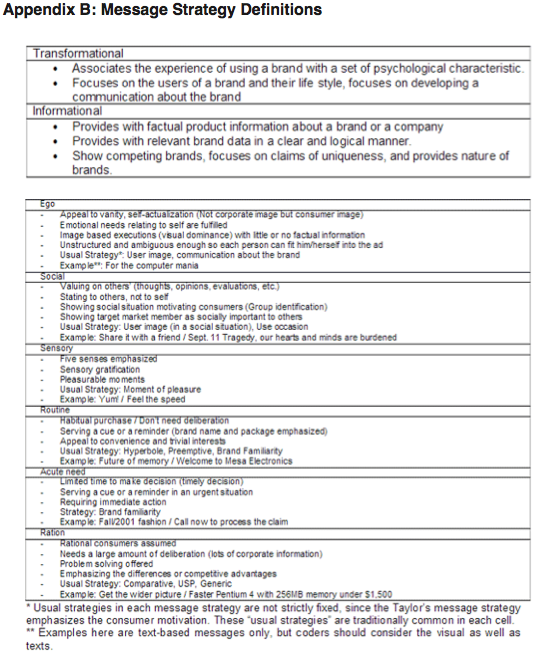From Elon Journal of Undergraduate Research in Communications VOL. 4 NO. 1Pumping Steel and Sex Appeal: Message Strategies and Content in Dietary Supplement AdvertisementsIII. MethodsContent Analysis This study used content analysis in order to thoroughly analyze the textual and visual message strategies present in dietary supplement ads. Content analysis describes a flexible method of analyzing data ranging from impressionistic, intuitive, interpretive analyses to systematic, strict textual analyses (Hsieh & Shannon, 2005). Researchers using this method create customized coding processes to index the information relevant to their research questions or can Chart 1. Taylor's model build upon coding schemes of others (Hwang, MacMillan, & Lee, 2003). Due to this versatility, the popularity of this research method increased drastically over the past few years, from only 76 studies reporting its use in 1991 to over 600 in 2002 (Hsieh & Shannon, 2005). Content analysis is applicable to both qualitative and quantitative studies. Both approaches using this method involve sampling relevant text and contextualizing the content using prior knowledge to answer predetermined research questions. The biggest difference lies in how data is collected and analyzed. Quantitative analyses begin from a research question or hypothesis determined before the research is conducted. Coding systems are created "a priori" or before the content analysis begins and are specifically designed to test or determine certain aspects of the content. In a qualitative analysis, the researcher will begin analyzing the content without a predetermined coding scheme and allow correlations in the content to form naturally. The data collected is then analyzed with the constant comparative technique based on emergent patterns, relationships and categories that are continually refined as new data are compared with old data (Hsieh & Shannon, 2005). Sampling Process This study used both a qualitative and quantitative approach to content analysis. Eighty-two print advertisements for fitness-related dietary supplements were selected to adequately analyze the relationship between the type of message appeal and the information provided about the supplement. Two publications with strong focuses on physical fitness and overall health were chosen to create a sample with a concentration on fitness. Popular men's fitness and lifestyle magazine Men's Health and bodybuilding magazine Muscle & Fitness were chosen to get advertisements geared toward men ranging from innocuous meal replacement supplements to the more intense bodybuilding supplements, which tend to contain a higher number of unfamiliar ingredients with possible health risks. Advertisements were chosen based on the FDA definition of dietary supplements as any product "containing a vitamin, a mineral, a herb or other botanical agent, an amino acid, weight-loss supplement, or herbal remedy." The study only used ads that were at least a full page in size. Fourteen ads from five issues of Men's Health and 70 ads from 3 issues of Muscle & Fitness gave a total of 83 coded advertisements. Coding Process A coding scheme (Appendix A) was constructed based on the coding scheme from Hwang, McMillan & Lee and used to record the relevant components each advertisement contains (2003). The author coded the sampled ads for the type of supplement being advertised and the message strategy of three parts in advertisements: headlines, images, and body copy. The headline was defined as the primary message of the advertisement and usually discerned by its placement and prominence on the ad. Headlines were coded for segments of Taylor's Six-Segment Strategy Wheel. Each advertisement could be classified into more than one of the six categories on the wheel if it has multiple kinds of appeals. Headlines were then coded based for a General Message Strategy of transformational or informational based on a 5-point Likert scale from "Entirely Transformational" to "Entirely Informational" with "Both Informational and Transformational" in the middle. General Message Strategy was determined by which Taylor segments were present in each headline. If the headline contained only transformational segments, such as Ego, Social, or Sensory strategies, it was coded as Entirely Transformational; if only informational segments, such as Ration, Acute Need, or Routine, were present, it was coded as Entirely Informational. When an ad had more informational segments than transformational ones, it was coded as More Informational. When an ad had two segments evenly, it was coded as Both Informational and Transformational. For example, the headline "Pure Power. Raw Energy." was coded as containing elements of Ego for its appeal to increasing one's own power and Sensory for the physical sensations that "raw energy" is meant to evoke. The measurement of this headline on the General Message Strategy, therefore, was Entirely Transformational. The same coding scheme was applied to analysis of images. Images were further coded with 4 dichotomous questions: if the supplement is shown, if the supplement is shown in use, if the image contains a person, and if the person or supplement is the main focus of the image. The author evaluated the tone of the body copy for the general message strategy present in each ad's copy. Body copy was further analyzed focusing on 7 variables that could be answered "yes" or "no." These included references to a scientific study, price, taste, testimonials, specific ingredients, and health benefits, with the presence of the FDA disclaimer as the final variable. The coding results were analyzed for common trends among the advertisements. IV. FindingsMessage Strategies By coding a total of 82 dietary supplement advertisements, this study tried to answer which type of message strategy as defined by Taylor's Message Strategy Wheel was most frequently used in DS advertising. Of the six segments, only Ego, Social, Sensory, and Ration appeared with any frequency in the headline, image, or body copy of advertisements as displayed in Table 1.
Ego appeals were the most prevalent in the headlines and images of the advertisements, followed by Ration in both cases. Under body copy the relationship was reversed, with Ration appeals appearing more frequently than Ego. It's important to remember that these numbers don't represent a mutual exclusivity of appeals. Most of the advertisements coded in this study contained multiple appeals throughout the headlines, images, and copy. Combining these numbers with the overall message strategies shown in Table 2 creates a more informative picture of how these appeals are being used.
Evaluating the overall message strategies in the advertisements' three main components revealed a strong tendency towards transformational appeals (Ego, Social, and Sensory) in both the headlines and images. Body copy was the only section where informational appeals were used more frequently than the transformational counterpart. From the information presented in these two tables, it can be found that DS advertisers put stronger focus on transformational appeals to capture potential customers' attentions with headlines and images, rather than informational appeals. 34 of 82 ads (42%) featured predominantly transformational appeals in both the Headline and Image, and 23 of those (68%) were balanced by a predominantly informational body copy. Information and Content The second research question of this study aimed to analyze the information given about supplements in their advertisements. One of the most important features the author looked for was the presence of the DSHEA disclaimer: "These statements have not been evaluated by the FDA. This product is not meant to diagnose, treat, cure or prevent any disease." Exactly 50% (41 ads) printed this disclaimer on the advertisement. While this disclaimer isn't legally required of all DS advertisements, its absence has potential to mislead uninformed consumers into believing that the product is government approved, effective, and safe. The guidelines for the disclaimer in DS advertisements from the FTC are not perfectly clear either, only requiring it if the ad gives evidence that the product has undergone FDA testing. This study also evaluated 5 elements advertisements used to persuade consumers to purchase their product: scientific backing, price, taste, testimonials, and ingredients. About 14 ads(17%) made some reference to scientific studies or research to validate the efficacy of their product, and 21 ads (26%) toated taste as a reason for purchase. Only 4 ads (5%) made any reference to price, either specifically or just in reference to affordability, and 14 ads(17%) gave a user testimonial in some capacity. All of the DS ads listed some kind of benefit from taking their product. These benefits ranged from vague ("increase performance") to more specific ("8x more weight loss than other trials") but only 42 ads (51.2% ) included any specific ingredients to support the claims made. For a majority of the ads, consumers must take it on the word of the advertiser that there is something in the product that actually delivers the promised results. Overall, this research revealed a lack of quality information about supplements in their advertisements. This lack of important detailed information in addition to a larger presence of transformational message strategy shows an unpleasant trend erring on the side of deception in DS advertising. While it was noted that message strategies in the ads are somewhat balanced, a message strategy focuses more on how information is stated than what information is actually present. Even in the 13 ads (16%) that used a more or entirely informational strategy in all three categories, only 7 contained a benefit and specific ingredient associated with it. To further analyze the informational content of the DS advertisements, the author broke down the ads into 12 categories of supplement types. Table 3 shows the distribution of 87 supplements over nine categories, with a final category labeled as "Other" combining three categories that contained only one supplement each. Four advertisements featuring more than one supplement caused a disparity between the total number of ads (82) and supplements (87).
Using these supplement categories, the data were analyzed for each type of supplement. Table 4 shows the percentage of ads in 6 of the categories that list a specific ingredient to substantiate their claimed benefit and the percentage using the FDA disclaimer. These two factors were found to be most relevant as they directly relate to safety and efficacy concerns. Testosterone supplements were the worst offenders, with none of the ads featuring any specific ingredients and only 2 containing the FDA disclaimer. One ad for QNT TESTEK Testosterone & Anabolic Growth Optimizer listed "a cutting edge, patent pending ingredient" with no identification while claiming it will "raise the testosterone:cortisol ratio up to 184%" and increase "growth factor levels by up to 333%." There were also no implications that the product was ever tested to validate those claims by any third party.
Pre-workout supplements and Thermogenics didn't show a marked improvement over testosterone either. Only 23.8% of pre-workout supplements and 26.7% of thermogenics listed ingredients, and in many of the ads the only listed active ingredient was caffeine for energy. When specific active ingredients were listed, it was generally a scientific title, such as "NOSPEP, a unique NOS Activating Bioactive Peptide Fraction" from a pre-workout supplement Vasotropin ad.Continued on Next Page » Suggested Reading from Inquiries Journal
Inquiries Journal provides undergraduate and graduate students around the world a platform for the wide dissemination of academic work over a range of core disciplines. Representing the work of students from hundreds of institutions around the globe, Inquiries Journal's large database of academic articles is completely free. Learn more | Blog | Submit Latest in Business & Communications |

